I've personally never been the biggest fan of there being such an insane variety of demons and evils because, in theory, each one of these enemies will end up subscribing to the typical rule of demons/devils/yugoloths reforming in their native plane if they're not killed there or whatever, but there's a huge market for these creatures, and I definitely appreciate that 5th Edition's expansion book for demons really ended up trying to give us a fair amount of diversity among the options.
Mordenkainen's Tome of Foes split these up alphabetically, but I'm going to cover them all in a single page so I don't have all my Reviewing D&D Monsters pages be taken up by random huge chunks of demons and devils. It's more thematically appropriate anyway. Click here for a primer on D&D fiends when I first covered the 'basic' ones introduced in the 5th Edition Monster Manual!.
- Click here for the previous part of Mordenkainen's, covering Eladrin to Nightwalkers.
- Click here for the next part of Mordenkainen's, covering devils and yugoloths.
- Click here for the index.
________________________________________
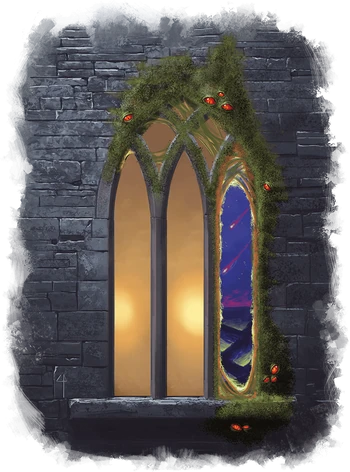
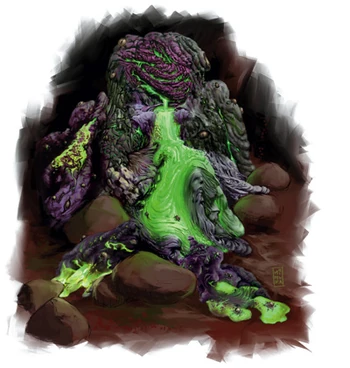
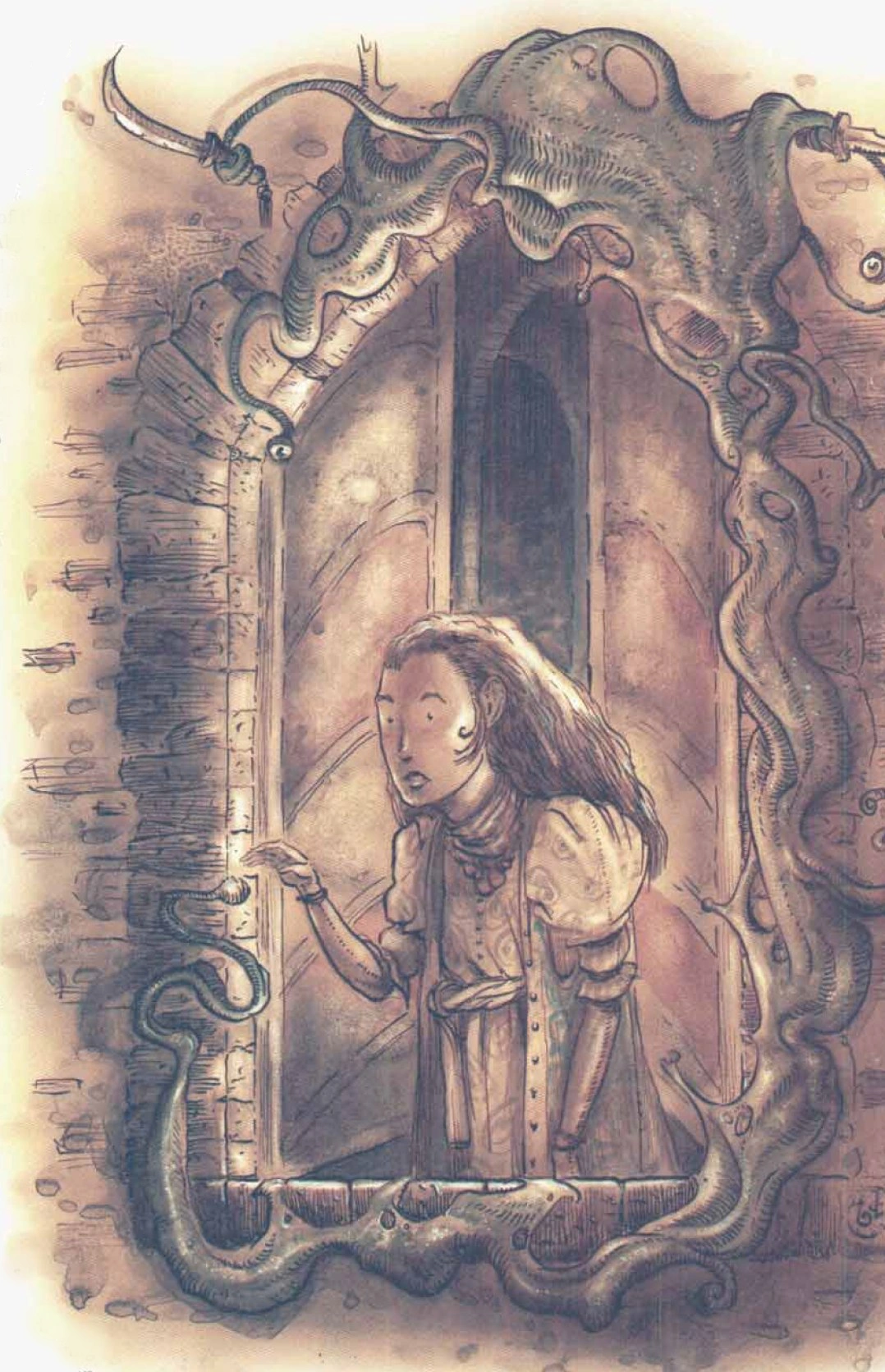
Demons: Alkilith
- 5.5E/5E: Medium Fiend - Demon; Chaotic Evil; CR 11
See, the thing about Alkiliths is that when this demon-moss has taken root around a doorway, they weaken the fabric of reality and allow other demons to invade, which is such a fun concept! The idea of a demonic moss is great, the idea of a creature that is obsessed with turning real doorways into portals to summon even more demonic buddies even moreso. Despite not being particularly flashy, the Alkilith is easily one of my favourite things in Mordenkainen. Oh, and since Mordenkainen is kind of big on expanding the actual lore of the demon lords and whatnot, some of these fiend variants are a bit more specialized -- the Alkilith's unique nature is because it's the spawn of the demon lord Juiblex, who we'll cover in a bit down the line.

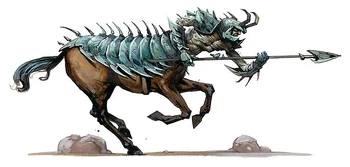
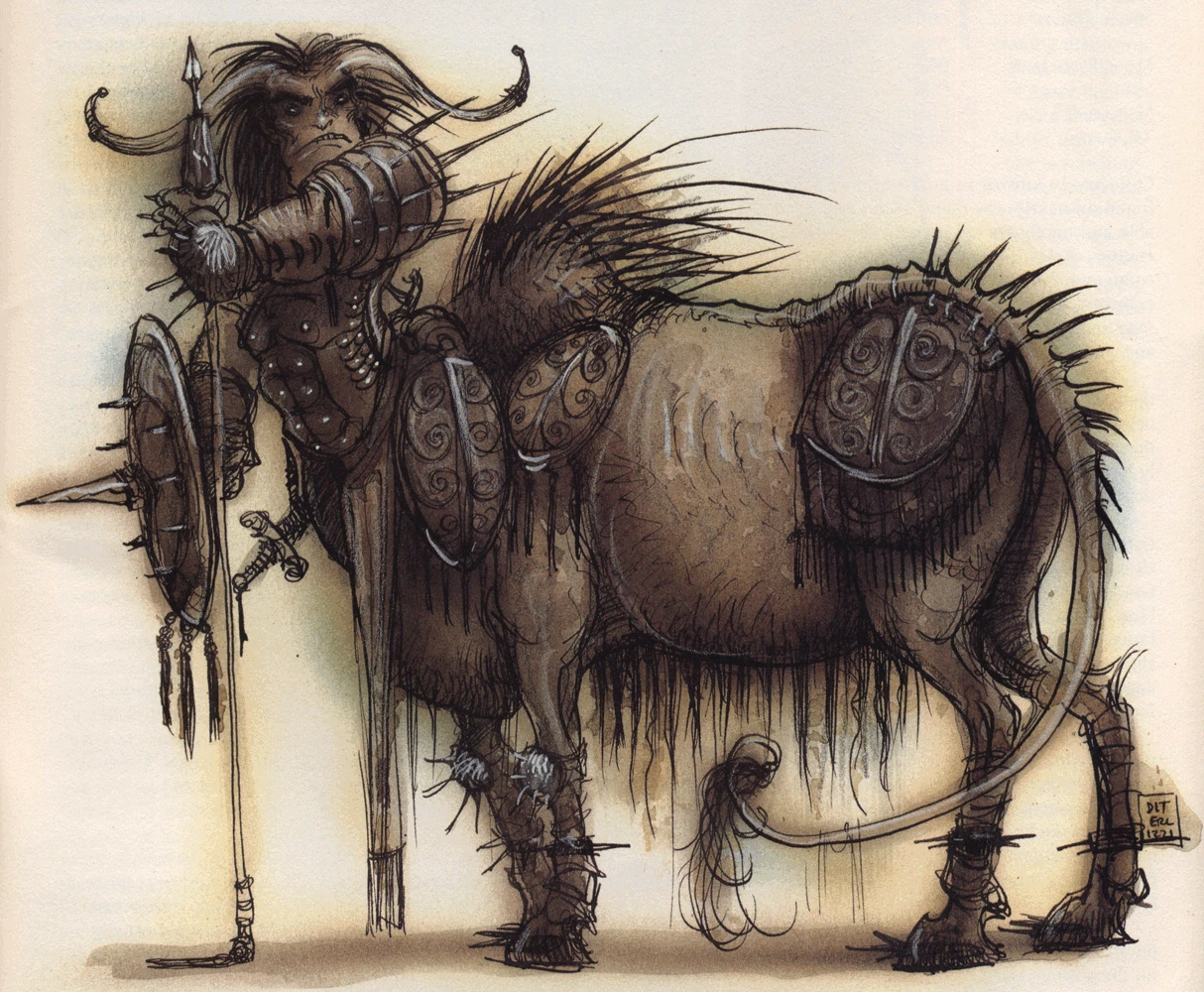
Demons: Armanite
- 5.5E/5E: Large Fiend - Demon; Chaotic Evil; CR 7
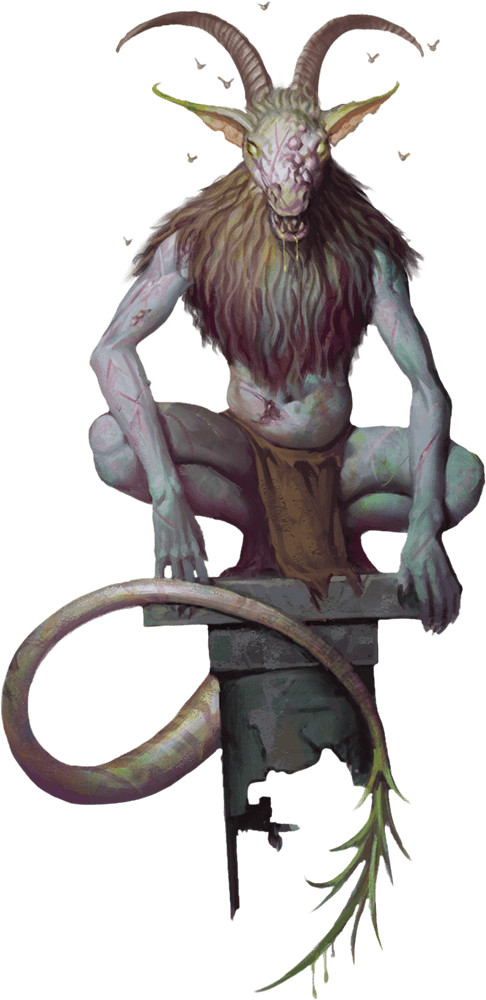
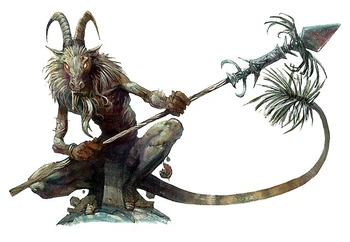
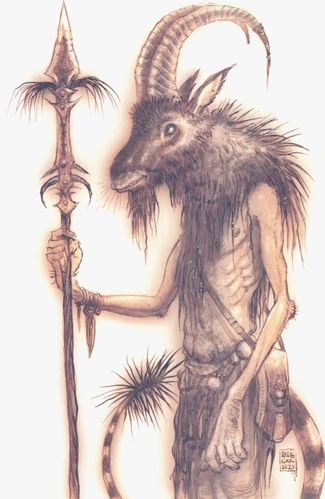
Demons: Bulezau
- 5.5E/5E: Medium Fiend - Demon; Chaotic Evil; CR 3
There's not a whole ton for me to say here, really, because demons like Bulezau and Armanite are just... kinda there, y'know? Cool, creepy designs that don't look too strong, and they have the copy-paste "vile, violent and chaotic" mentality that demons have. Although considering how a fair amount of demons in the original Monster Manual are noted to be subversions of what the sourcebooks insist that demons are (the Glabrezu, Nalfeshnee and Yochlol being the primary offenders), I guess it's neat to see a bunch more of the 'everyman' demon. Plus, these are weak enough to toss as the starter enemies of a fiend-heavy campaign instead of just resorting to the poor Chasme and Vrock all the time, y'know?
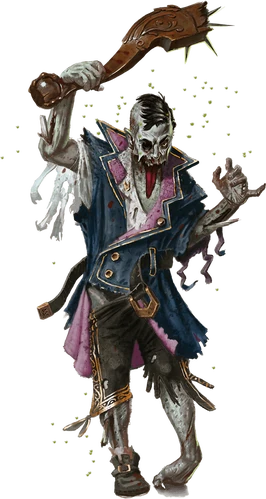
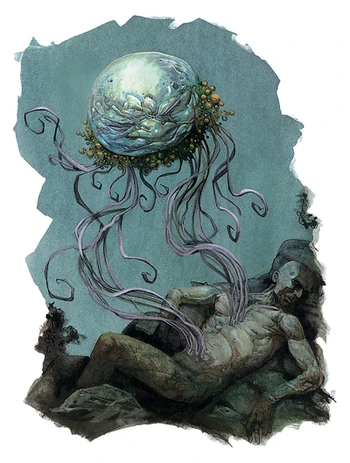
Demons: Dybbuk
- 5.5E/5E: Medium Fiend - Demon; Chaotic Evil; CR 4
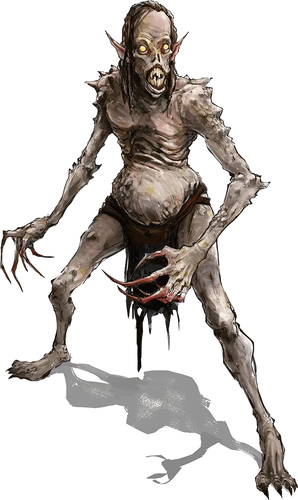
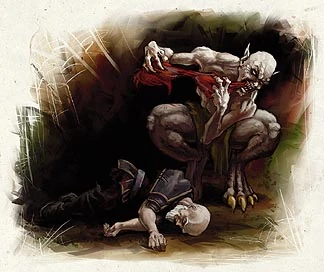
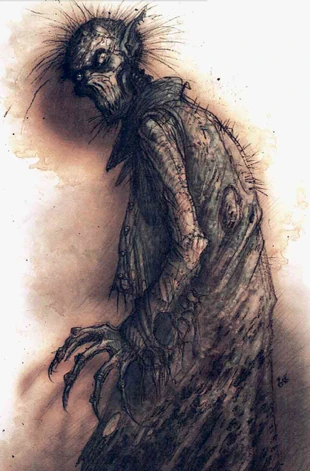
Demons: Maurezhi
- 5.5E/5E: Medium Fiend - Demon; Chaotic Evil; CR 7

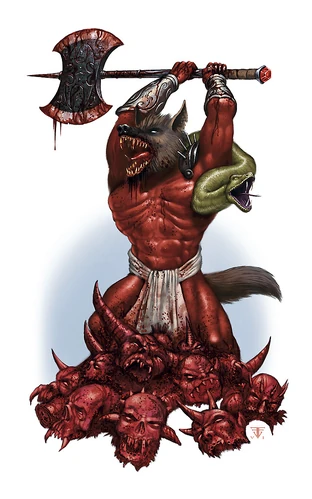
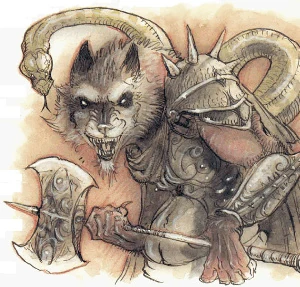
Demons: Molydeus
- 5.5E/5E: Huge Fiend - Demon; Chaotic Evil; CR 21
In most of its appearances, the Moly is a mighty demon that sort of acts like the 'elite guard' to demon lords, apparently more feared than even the Balor. It's neat to have a bunch more powerful demons, I guess? Apparently the Molydeus are created when a demon lord really likes one of its minions, then transforming it (through torture and painful spells, because demons) into a two-headed muscleman. Oh, and it also gets a weapon made from part of its soul, which has Bleach-esque powers. That's cool! The snake head is basically a communicator that the Molydeus's master can peer through and command the Molydeus, to really ensure that the Moly won't get any funny ideas -- which is important because one of the tasks that Moly is expected to do is to guard its master's amulet, which is like, a demon lord's phylactery that allows them to regenerate should they be destroyed. Anyway... not a bad design, just one that I never really found all that memorable.

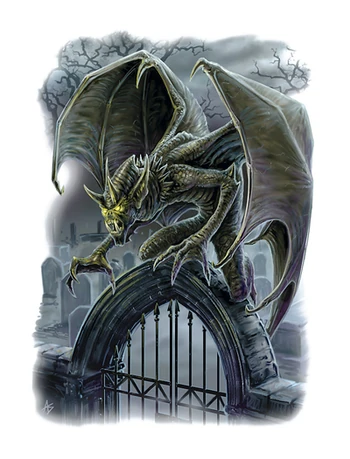
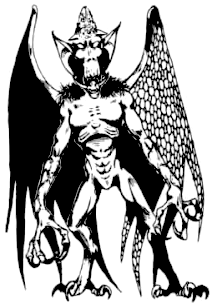
Demons: Nabassu
- 5.5E/5E: Medium Fiend - Demon; Chaotic Evil; CR 15
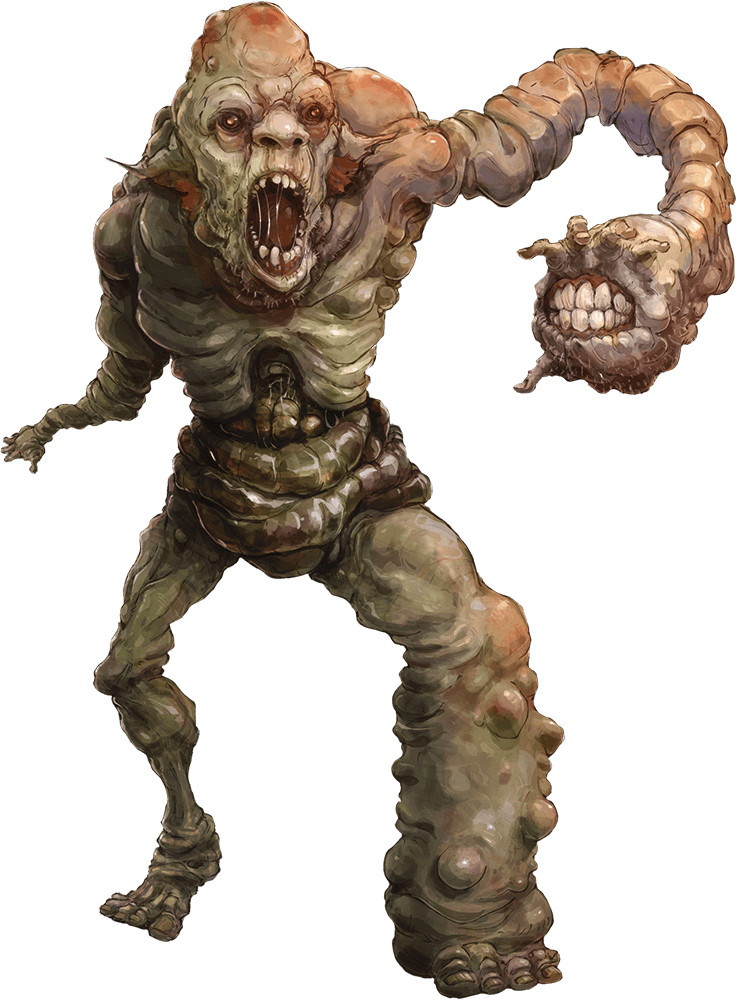
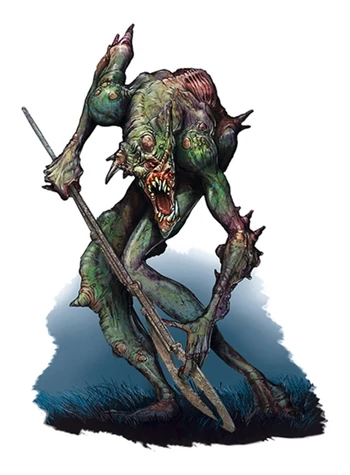
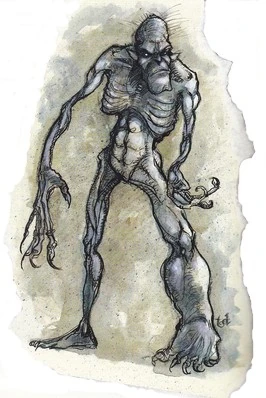
Demons: Rutterkin
- 5.5E/5E: Medium Fiend - Demon; Chaotic Evil; CR 2 (Rutterkin), 1/4 (Abyssal Wretch)
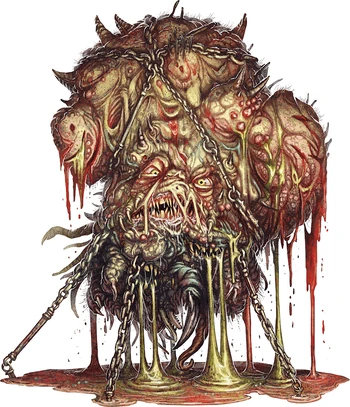
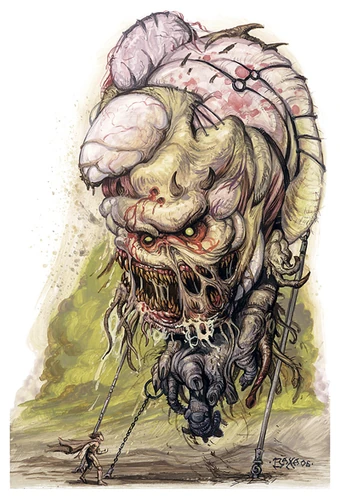
Demons: Sibriex
- 5.5E/5E: Huge Fiend - Demon; Chaotic Evil; CR 18
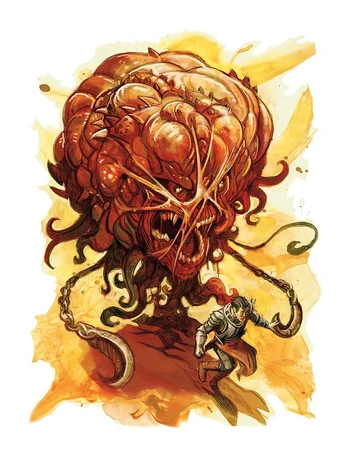 |
| 4E Sibriex |
The Sibriex will bleed rivers of blood and bile and while they are chained in place, they will use their blood and stuff to create more demons and horrors out of other creatures. 5E in particular credits the Sibriex as being responsible for the warped appearance of the Rutterkins, which they create a large amount of in order to spread their influence. Sibriex also provide the service of "Flesh Warping", which is something that some demons petition Sibriexes for, but it's also a weapon that the Sibriex uses in combat, with Mordenkainen providing a table for your DM to roll and decide what effect the Sibriex causes on you -- which may or may not be permanent depending on how badly you fuck up! Sometimes it's just as mundane as your character's hair becoming blue, or even something beneficial like growing wings or whiplike tails, or good ol' Cthulhu-fication of having limbs becoming tentacles. And then some of the flesh warping effects are hilariously horrifying. "The target's ears tear free from its head and scurry away, the target is deafened." or "The target's arms and legs switch places, preventing the target from moving unless it crawls." 5E highlights the flesh-warping aspects of the Sibriex a bit more, but I do like the idea of these bound, super-duper-ancient demons that even other demon lords respect.
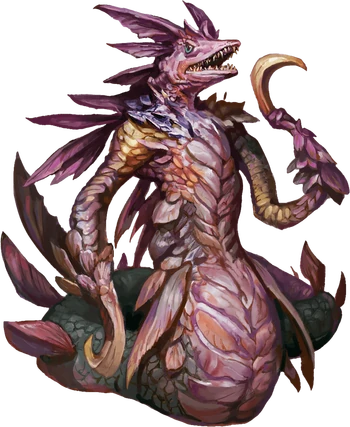
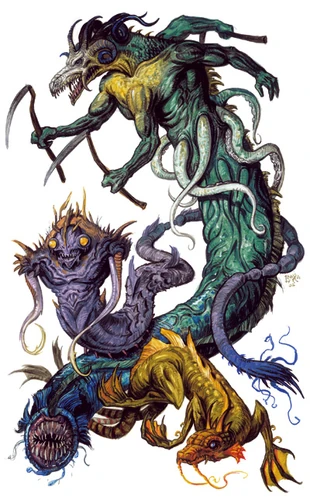
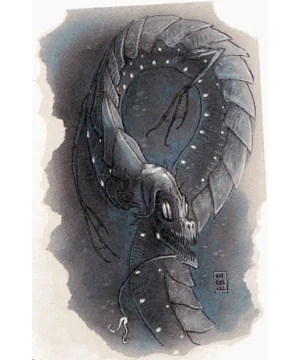
Demons: Wastrilith
- 5.5E/5E: Large Fiend - Demon; Chaotic Evil; CR 13
____________________________________________
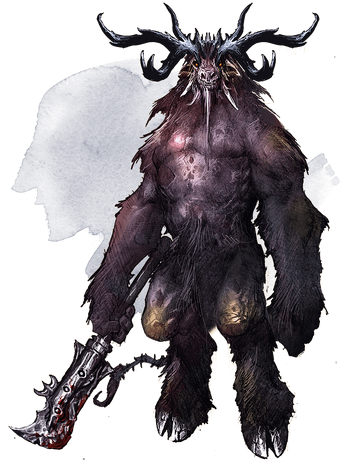
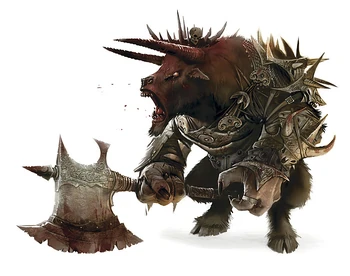
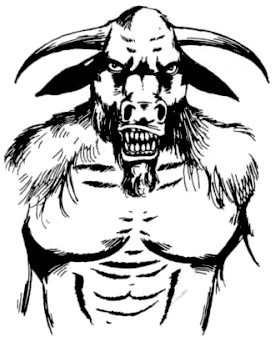
Demon Lord Baphomet
- 5.5E/5E: Huge Fiend - Demon; Chaotic Evil; CR 23
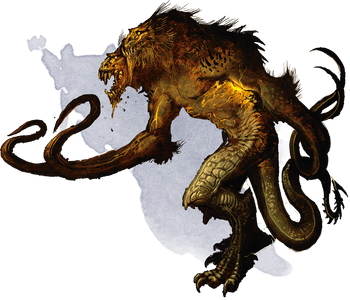
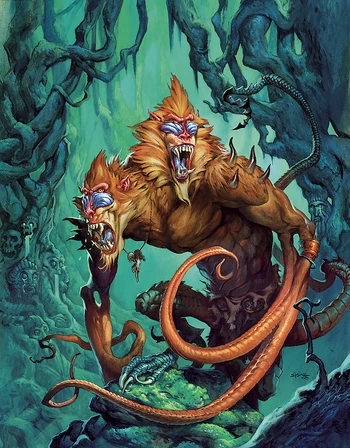
Demon Lord Demogorgon
- 5.5E/5E: Huge Fiend - Demon; Chaotic Evil; CR 26
 |
| 1E Demogorgon |
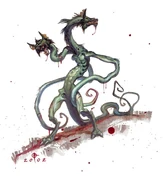 |
| 2E Demogorgon (!!!) |
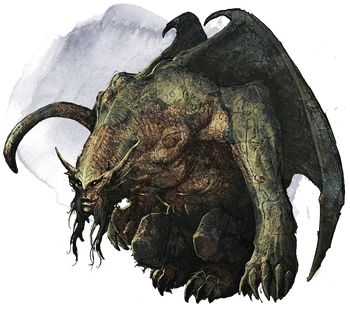
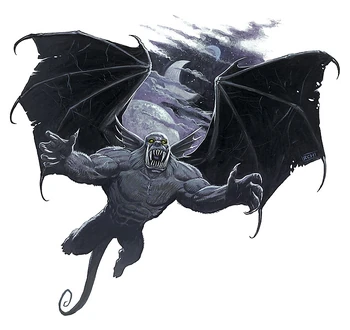
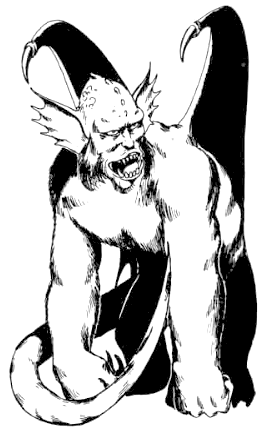
Demon Lord Fraz-Urb'luu
- 5.5E/5E: Large Fiend - Demon; Chaotic Evil; CR 23
He is one of the more iconic villains from D&D's Greyhawk setting, I think, because Mordenkainen's references a very delightfully Legend-of-Zelda-esque backstory where Fraz-Urb'luu was imprisoned beneath a castle and it's a race between his followers and a bunch of adventurers in hunting pieces of a shattered staff across the land to free him. His lair is the demonic city of Zoragmelok in the realm of Hollow's Heart, which, unlike the wide dream-scapes and illusions he's known for, is just a featureless plain of white dust. Anyway, this is kind of an iconic villain, and I respect Fraz for that, but typing his name is a headache.

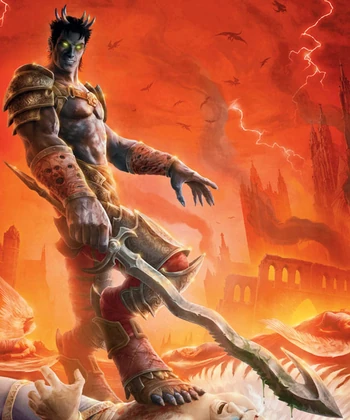
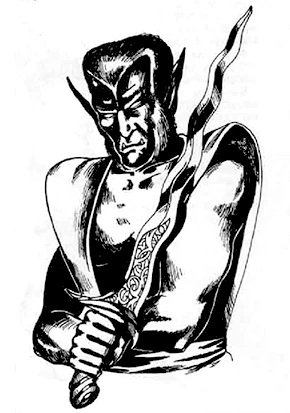
Demon Lord Graz'zt
- 5.5E/5E: Large Fiend - Demon; Chaotic Evil; CR 24
Oh, hey, it's Darth Maul! It's kind of an obligation that in any gathering of supervillains, one of them must be the 'pretty boy' one, and among the demon lords, Graz'zt is that, looking the most humanoid out of his compatriots, being a dark-skinned muscular handsome man with little horns on top. And Graz'zt, of course, is the prince of "untamed desire", with the lore noting that Graz'zt is inhumanely beautiful, but anyone who meets him knows that there's just something wrong with him, something slightly off. He's handsome but his expression's just a bit off; his features are perfect but he's got the wrong number of fingers or something, and I think this whole mixture of beauty and wrongness is Graz'zt whole theme. Anyway, his whole theme is lust and obviously his cultists engage in like, non-kosher BDSM and orgies and whatnot. It's a sex-worshiping demon cult! And while Graz'zt prefers pleasure and manipulation, he's still a demon lord with a CR of 24, and he's going to murder anyone that defies him with his blade Angdrelve (or "Wave of Sorrow"). D&D can't really get away with describing anything too graphic, but we are all adults here, we know that Graz'zt's basically all about pain-and-pleasure BDSM orgies. Not much to say here design-wise, but I recognize that a more pleasure-oriented Demon Lord like Graz'zt is necessary to balance out the others.
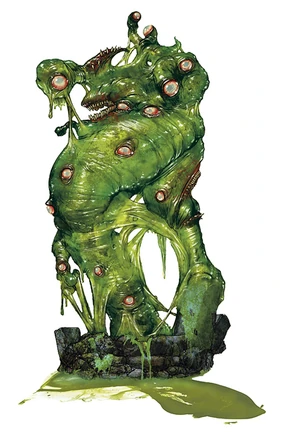
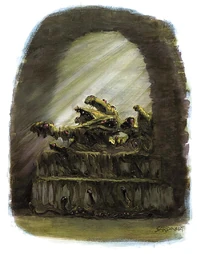
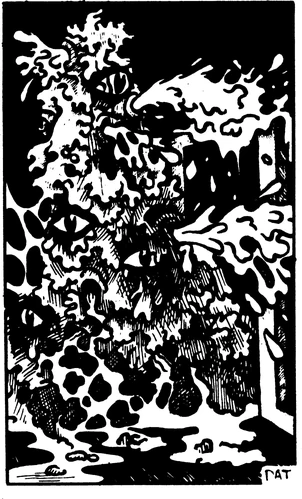
Demon Lord Juiblex
Juiblex the Faceless Lord is another one that gives me a bit of a trouble in spelling -- I keep typing his name as the more natural-sounding Jubilex! Juiblex's visual design isn't super duper creative either, just a giant goopy jelly slime with eyeballs and fanged mouths dotting its entire body. It's a neat design, sure, because I like slime monsters and its a nice break from the horns-and-wings humanoids... but I kind of feel that his (pretty cool) artwork could've been a bit cooler for something that's supposed to be the big daddy of all slimes in the multiverse, yeah? Juiblex fills another supervillain niche, this time being the trope of the idiot, mindless being who just wants to end the world. Juiblex wants to end the world, not caring about plots, schemes or power plays, but that's because all it wants is to consume everything, to slake its hunger and turn the entire world into nothing but Juiblex, dissolving everything into slimes.
So this does raise some interesting questions about the slimes in D&D. While we do have explicit demonic slimes that serve Juiblex (the Alkilith we covered earlier) what about the other slimes of the world? The Gelatinous Cubes and Ochre Jellies and all those? Are they still part of Juiblex in some way? Are oozes technically, then, demons? Demon-spawn? Juiblex also has mortal followers, most of whom find themselves transformed into slime-people who end up slowly losing their individuality as Juiblex consumes them and turns them into literal slime... tragically, none of these slime-cultists get any artwork here. Come on. Juiblex, interestingly, has a roommate in the Abyss, hanging out in the realm of Shedaklah with fellow demon lord Zuggtmoy. They fight for territory, but it kind of comes off as the two of them being terrible roommates in a comedy sitcom. Anyway, I like Juiblex, but there really isn't a whole ton to talk about him.
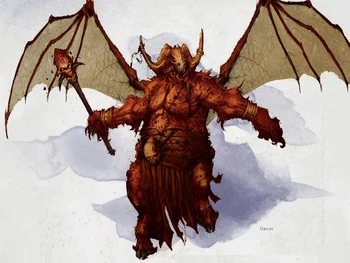
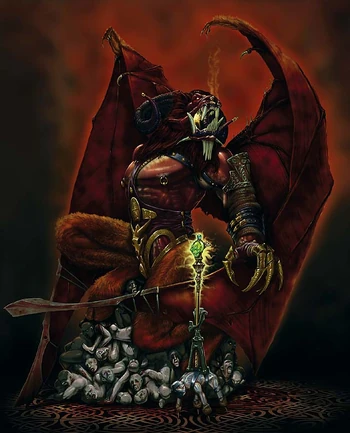
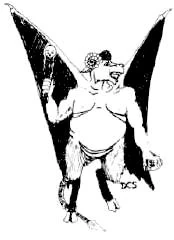
Demon Lord Orcus
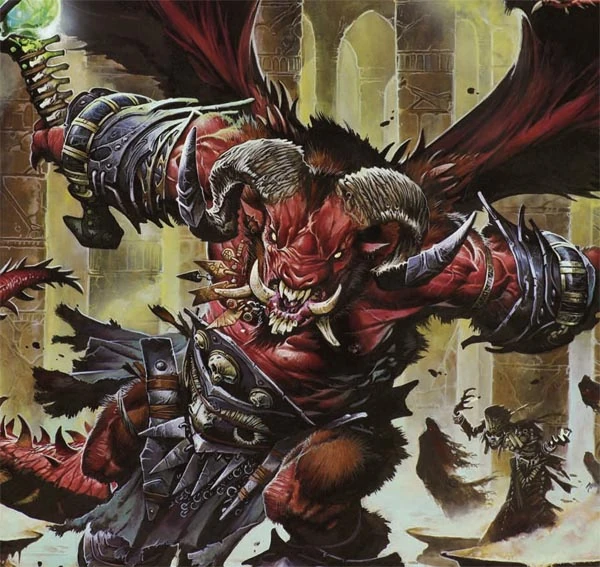 Another one that keeps showing up in every dang edition of D&D is the demon lord Orcus, arguably the definitive D&D villain to some. Portrayed relatively consistently as a heavily-built humanoid with the typical classic 'demon' look, Orcus is a design that we've seen so many times in other depictions of demonic entities -- red skin, horns, fangs, bat wings, tails, hooved feet... yet I suppose it's appropriate that one of the original examples of demon lords looks like the most common pop culture depiction of demons. Orcus is known as the Prince of Undeath, the Blood Lord, and is the being responsible for the presence of undead beings and especially the cannibalistic ghouls. He's your regular evil death-god. Orcus's whole modus operandi is to kill every single goddamn thing in the multiverse and turn them into undead, and his cults are filled with necromancers and warlocks that raise the dead in his name. I do like the little art evolution from the older depictions of Orcus -- particularly 5E's decision to give him a skull for a head, which is a lot more appropriate for the demon lord of undeath. 4E does give him a pretty damn cool art piece which became the cover for that edition's Monster Manual.
Another one that keeps showing up in every dang edition of D&D is the demon lord Orcus, arguably the definitive D&D villain to some. Portrayed relatively consistently as a heavily-built humanoid with the typical classic 'demon' look, Orcus is a design that we've seen so many times in other depictions of demonic entities -- red skin, horns, fangs, bat wings, tails, hooved feet... yet I suppose it's appropriate that one of the original examples of demon lords looks like the most common pop culture depiction of demons. Orcus is known as the Prince of Undeath, the Blood Lord, and is the being responsible for the presence of undead beings and especially the cannibalistic ghouls. He's your regular evil death-god. Orcus's whole modus operandi is to kill every single goddamn thing in the multiverse and turn them into undead, and his cults are filled with necromancers and warlocks that raise the dead in his name. I do like the little art evolution from the older depictions of Orcus -- particularly 5E's decision to give him a skull for a head, which is a lot more appropriate for the demon lord of undeath. 4E does give him a pretty damn cool art piece which became the cover for that edition's Monster Manual.
Orcus lives in the fortress of Naratyr, located on the layer of Thanotos, and while Mordenkainen's doesn't go into too much detail about his backstory, what I remember from previous editions indicate that Orcus wasn't born a demon lord, but was once a mortal spellcaster who died and was cast into the Abyss, and his soul slowly grew from a lowly Larva all the way up the ranks of demonkind into a Balor before eventually achieving godhood and becoming the only demon lord to challenge the throne of 'Demon Prince' from Demogorgon. Over the various editions of D&D, Orcus has been killed and resurrected multiple times, which I suppose is appropriate for a death-god demon. Without going into the specifics of Orcus's backstory or abilities (which will take us a while) there's really not a whole ton to talk about him, though.
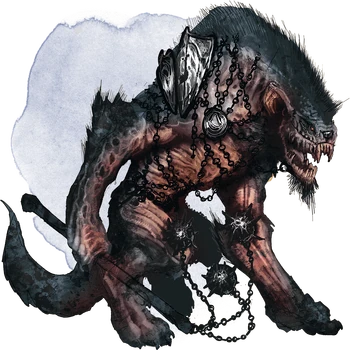
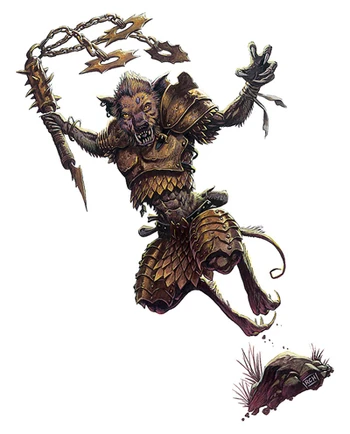

Demon Lord Yeenoghu
While he doesn't quite have as impressive a resume as the likes of Orcus, Demogorgon or Asmodeus, Yeenoghu kind of keeps being fairly prominent in D&D material for the simple reason that his favoured race, the gnolls, are themselves very prominent in D&D material. Yeenoghu isn't super interesting design-wise, just a bigger, more savage gnoll with a triple-tipped flail. 5E does give him an awesome artwork that truly embodies the "Beast of Butchery" and makes him look far more feral and demonic than most gnolls, but in previous editions he's kind of underwhelming. As a Demon Lord, Yeenoghu's just crazy, violent, and all about the senseless slaughter and destruction, and he shows up a lot in the backstories of gnolls and their ilk. Yeenoghu is neat, again, as a springboard of (admittedly simple) backstory for the gnolls, but otherwise I can't really think of much to say about it.
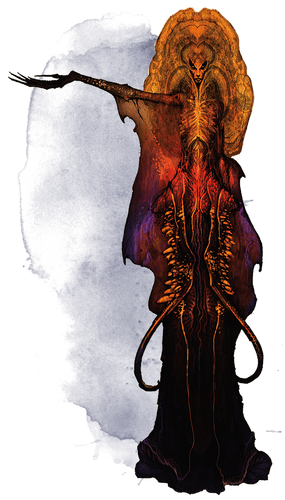
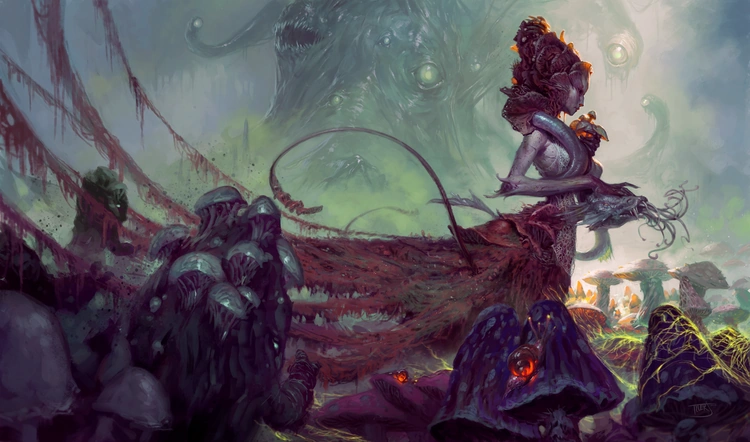
Demon Lord Zuggtmoy
I don't think Zuggtmoy has had much of a career outside of 5E, being name-dropped a couple of times in previous editions but never really getting much of a proper role until 5th Edition set her up as one of the primary antagonists of the Out of the Abyss adventure. Zuggtmoy is the Demon-Queen of Fungi and the Lady of Rot and Decay, and I am all about fungus-themed enemies. I guess we know why Zuggtmoy gets along pretty well with Juiblex so much that they're essentially roommates, because Zuggtmoy is detached and has such an alien mind that all she wants to do is to spread her spores to infect the living and turn them into her mushroom minions. It's a neat difference compared to the more brutal mentality of the other Demon Lords.
Despite Zuggtmoy's two artworks depicting her as a slender humanoid woman with a mushroom-themed dress and tendrils and whatnot, this is obviously not her true form, it's just what she chooses to appear as when she mooshes together her fungal form. Zuggtmoy's cultists are also basically slowly being mind-controlled by her fungal spores, after having been promised something relatively innocent like a boost of power after eating a mushroom. Pro tip in D&D, if a suspicious NPC offers you a very cheap Potion of Giant's Strength with a suspicious-looking toadstool floating inside... don't drink it! Your DM isn't that nice. Tragically, though, like Juiblex's slime-cultists, we don't get to see any of the fungi-faced cultists of Zuggtmoy represented in artwork, which I assume will look like those fungus-folk from Darkest Dungeons. I really do like Zuggtmoy, although part of it is admittedly thanks to me really liking fungi as the basis for monster concepts.
That's all the Demon Lords that are statted in Mordenkainen's, with the biggest omission being the Drow's Spider-Queen Lolth which I think is covered in another book, although we do get a chunk of her lore and origin in the 'elf' section. And... and I feel like I ended up not having as much to say about them, really. I do kind of feel like we probably could've had more lore about the Demon Lords themselves, although I'm pretty sure that those are covered in other books and whatnot.
The 5E stats for these creatures:



Demon Lord Juiblex
- 5.5E/5E: Huge Fiend - Demon; Chaotic Evil; CR 23
So this does raise some interesting questions about the slimes in D&D. While we do have explicit demonic slimes that serve Juiblex (the Alkilith we covered earlier) what about the other slimes of the world? The Gelatinous Cubes and Ochre Jellies and all those? Are they still part of Juiblex in some way? Are oozes technically, then, demons? Demon-spawn? Juiblex also has mortal followers, most of whom find themselves transformed into slime-people who end up slowly losing their individuality as Juiblex consumes them and turns them into literal slime... tragically, none of these slime-cultists get any artwork here. Come on. Juiblex, interestingly, has a roommate in the Abyss, hanging out in the realm of Shedaklah with fellow demon lord Zuggtmoy. They fight for territory, but it kind of comes off as the two of them being terrible roommates in a comedy sitcom. Anyway, I like Juiblex, but there really isn't a whole ton to talk about him.



Demon Lord Orcus
- 5.5E/5E: Huge Fiend - Demon; Chaotic Evil; CR 26
 Another one that keeps showing up in every dang edition of D&D is the demon lord Orcus, arguably the definitive D&D villain to some. Portrayed relatively consistently as a heavily-built humanoid with the typical classic 'demon' look, Orcus is a design that we've seen so many times in other depictions of demonic entities -- red skin, horns, fangs, bat wings, tails, hooved feet... yet I suppose it's appropriate that one of the original examples of demon lords looks like the most common pop culture depiction of demons. Orcus is known as the Prince of Undeath, the Blood Lord, and is the being responsible for the presence of undead beings and especially the cannibalistic ghouls. He's your regular evil death-god. Orcus's whole modus operandi is to kill every single goddamn thing in the multiverse and turn them into undead, and his cults are filled with necromancers and warlocks that raise the dead in his name. I do like the little art evolution from the older depictions of Orcus -- particularly 5E's decision to give him a skull for a head, which is a lot more appropriate for the demon lord of undeath. 4E does give him a pretty damn cool art piece which became the cover for that edition's Monster Manual.
Another one that keeps showing up in every dang edition of D&D is the demon lord Orcus, arguably the definitive D&D villain to some. Portrayed relatively consistently as a heavily-built humanoid with the typical classic 'demon' look, Orcus is a design that we've seen so many times in other depictions of demonic entities -- red skin, horns, fangs, bat wings, tails, hooved feet... yet I suppose it's appropriate that one of the original examples of demon lords looks like the most common pop culture depiction of demons. Orcus is known as the Prince of Undeath, the Blood Lord, and is the being responsible for the presence of undead beings and especially the cannibalistic ghouls. He's your regular evil death-god. Orcus's whole modus operandi is to kill every single goddamn thing in the multiverse and turn them into undead, and his cults are filled with necromancers and warlocks that raise the dead in his name. I do like the little art evolution from the older depictions of Orcus -- particularly 5E's decision to give him a skull for a head, which is a lot more appropriate for the demon lord of undeath. 4E does give him a pretty damn cool art piece which became the cover for that edition's Monster Manual.Orcus lives in the fortress of Naratyr, located on the layer of Thanotos, and while Mordenkainen's doesn't go into too much detail about his backstory, what I remember from previous editions indicate that Orcus wasn't born a demon lord, but was once a mortal spellcaster who died and was cast into the Abyss, and his soul slowly grew from a lowly Larva all the way up the ranks of demonkind into a Balor before eventually achieving godhood and becoming the only demon lord to challenge the throne of 'Demon Prince' from Demogorgon. Over the various editions of D&D, Orcus has been killed and resurrected multiple times, which I suppose is appropriate for a death-god demon. Without going into the specifics of Orcus's backstory or abilities (which will take us a while) there's really not a whole ton to talk about him, though.



Demon Lord Yeenoghu
- 5.5E/5E: Huge Fiend - Demon; Chaotic Evil; CR 24


Demon Lord Zuggtmoy
- 5.5E/5E: Large Fiend - Demon; Chaotic Evil; CR 23
Despite Zuggtmoy's two artworks depicting her as a slender humanoid woman with a mushroom-themed dress and tendrils and whatnot, this is obviously not her true form, it's just what she chooses to appear as when she mooshes together her fungal form. Zuggtmoy's cultists are also basically slowly being mind-controlled by her fungal spores, after having been promised something relatively innocent like a boost of power after eating a mushroom. Pro tip in D&D, if a suspicious NPC offers you a very cheap Potion of Giant's Strength with a suspicious-looking toadstool floating inside... don't drink it! Your DM isn't that nice. Tragically, though, like Juiblex's slime-cultists, we don't get to see any of the fungi-faced cultists of Zuggtmoy represented in artwork, which I assume will look like those fungus-folk from Darkest Dungeons. I really do like Zuggtmoy, although part of it is admittedly thanks to me really liking fungi as the basis for monster concepts.
That's all the Demon Lords that are statted in Mordenkainen's, with the biggest omission being the Drow's Spider-Queen Lolth which I think is covered in another book, although we do get a chunk of her lore and origin in the 'elf' section. And... and I feel like I ended up not having as much to say about them, really. I do kind of feel like we probably could've had more lore about the Demon Lords themselves, although I'm pretty sure that those are covered in other books and whatnot.
The 5E stats for these creatures:
- Alkilith: Medium fiend - demon; chaotic evil; CR 11
- Armanite: Large fiend - demon; chaotic evil; CR 7
- Bulezau: Medium fiend - demon; chaotic evil; CR 3
- Dybbuk: Medium fiend - demon; chaotic evil; CR 4
- Maurezhi: Medium fiend - demon; chaotic evil; CR 7
- Molydeus: Huge fiend - demon; chaotic evil; CR 21
- Nabassu: Medium fiend - demon; chaotic evil; CR 15
- Rutterkin: Medium fiend - demon; chaotic evil; CR 2
- Abyssal Wretch: Medium fiend - demon; chaotic evil; CR 1/4
- Sibriex: Huge fiend - demon; chaotic evil; CR 18
- Wastrilith: Large fiend - demon; chaotic evil; CR 13
- Baphomet: Huge fiend - demon; chaotic evil; CR 23
- Demogorgon: Huge fiend - demon; chaotic evil; CR 26
- Fraz-Urb'luu: Large fiend - demon; chaotic evil; CR 23
- Graz'zt: Large fiend - demon shapechanger; chaotic evil; CR 24
- Juiblex: Huge fiend - demon; chaotic evil; CR 23
- Orcus: Huge fiend - demon; chaotic evil; CR 26
- Yeenoghu: Huge fiend - demon; chaotic evil; CR 24
- Zuggtmoy: Large fiend - demon; chaotic evil; CR 23
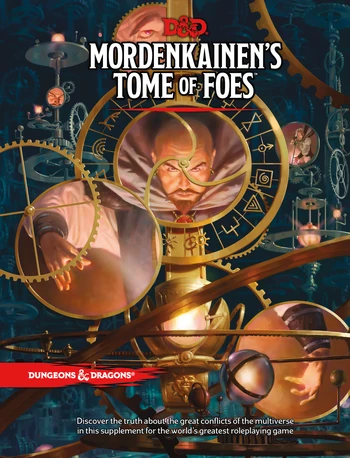
No comments:
Post a Comment